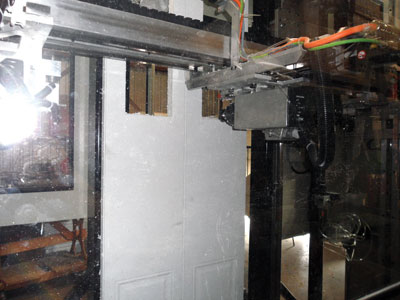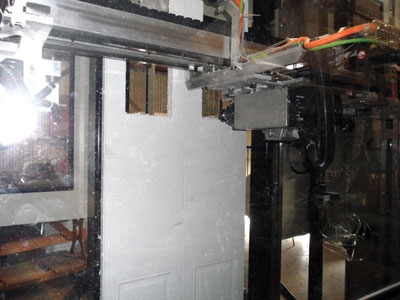
Canadian vertical door manufacturers are creating exciting new options for door manufacturers.
Canadian vertical door manufacturers are creating exciting new options for door manufacturers. By cutting door lites in an upright position using the latest three-axis CNC technology, they can achieve better removal of chips and dust and safer clamping of the workpiece. This leads to faster processing and more accuracy. But the key benefit of these innovative systems is the ability to cut finished doors without damage.
 |
|
| Vertical door cutting machines can cut lites, hinge holes, screw holes, and hardware holes all in one setup. Three-axis CNC processing means designers are limited only by their imaginations when it comes to custom lite shapes and positioning. Chips and dust are enclosed, and fall away from the cutting area. |
Door manufacturers have long had three basic choices when it comes to cutting lites: hand routing with templates, automatic two-axis routing or full CNC three-axis routing. Anyone who has cut lites all day with a hand router knows the drawbacks. The operator is reaching out over a horizontal surface, manipulating a heavy device that can backlash at any time. “One of the customers we sold our machinery to was doing it the old way,” Jonathan Chauvette explains. “He had to put tape on the floor to keep the operator from slipping.” Chauvette is the sales manager for JRC Machineries, national distributor of Eugenie vertical door cutting machines.
Two-axis machines are certainly easier to use and faster than hand routers, but are still limited in that they cannot
quickly change RPM for different cuts. So users are limited to changing tools if they want to perform different operations, or the same operation in a different material. This becomes a larger problem when machining steel and fibreglass doors. Door manufacturers today have to offer more options than ever before, and be more responsive to customers’ needs in order to compete successfully with offshore producers. The ability to quickly switch from wood to fibreglass to steel door production adds a crucial element of flexibility without adding two more machines.
With three-axis control, the machine can co-ordinate the spindle RPM and axis movement to achieve the best result for a given cutter. The cuts are clean and smooth, and accomplished at maximum speed. Chauvette says simultaneous three-axis control allows speeds up to 650 inches per minute in fibreglass, and 150 to 200 inches per minute in steel.
Three-axis control technology confers other benefits, as well. Customers can drill or punch holes to locate the screws for such special hardware as panic bars or the garden door clips popular with customers in western Canada. They can even make partial cuts for renovators who want hardware on one side of a door and not the other. Three-axis CNC allows for smooth execution of ovals and other shapes that are hard to do by hand.
Going vertical
Three-axis CNC routers are not unusual. What is different about vertical machines is their array of unique systems for holding the door upright, in a vertical orientation, while cutting. The first big advantage of this design is the effect on the machine’s footprint. A vertical door cutter takes up far less space on the shop floor than a horizontal router that could process the same size piece. For instance, Eugenie’s Sandy SS-A can process doors up to 85 inches high by 42 inches wide on a 6- by 10-foot footprint. A horizontal router capable of machining the same size piece would be around eight feet wide by 13 feet long.
The vertical orientation allows dust and chips to fall away from the cutting area rather than build up. This is a bigger advantage than you might think. Re-machining cutting waste is a major cause of cutter chatter and tool wear because the waste is unstable and harder than the original material. Horizontal operations often have to pause to blow sawdust away from the cutting zone. Vertical processes need to do this less.
Because vertical machines are smaller, they can be completely enclosed, while the cost to do this with a large horizontal machine would be prohibitive. Enclosed operations are safer, prevent dust from blowing around the shop and make dust and chip collection much easier. Door processors take on significant risks using unenclosed machinery.
An injury to a machine operator using an unenclosed machine is going to attract attention from provincial safety authorities, and that can ruin your whole day. Manufacturers working with fiberglass have a particular problem, as the dust is abrasive and quite dangerous to breath. Vertical door machines can keep the dust inside. Eugenie also protects the machine ways with covers to prevent the bearings from becoming fouled.
Paint first, cut later
A really beneficial feature for process engineers is the ability to clamp the workpiece on the top and bottom, allowing the machine to process finished doors without damaging the surface. In a horizontal process, dirt, dust and chips build up on the door’s surface and can stain the finish or scratch it when they are cleaned away. This is a particular problem for steel doors, where the chips come out hot. “Because we clamp top and bottom we liberate the side of the door,” Chauvette explains. “On our machine we have three stations. One main station is doing the cut-out and we have one right-hand station that is doing the side hole. And we can do all the multipoint holes on the door. Then we have a station on the other side doing the hinge holes. So we can do left, right or full hinge holes depending if the customer buys the doors pre-hung.”
Machining pre-finished doors is a process engineer’s dream. Engineers now have the flexibility to process standard door configurations and finish them later, or maintain a stock of pre-finished doors and machine them to suit the customer. Or, they can do both, and maintain efficiencies whether the customer is asking for a custom finish or a custom door configuration.
Vertical door machines can be easily integrated into processing lines, travelling along a roller track to be automatically drawn into the machine, clamped, machined, then rolled out to the next process. Going vertical may be the solution for door manufacturers looking to offer customers mass customization of styles, lite patterns and finishes.
 Eugenie’s Sandy SS-A features automated height adjustment, processing doors from 24 to 96 inches high without operator intervention. Eugenie’s Sandy SS-A features automated height adjustment, processing doors from 24 to 96 inches high without operator intervention.
Sandy SS-A specs at a glance |
Print this page

Leave a Reply